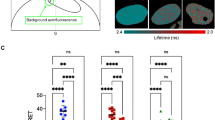Abstract
Mathematical models can integrate different types of experimental datasets, reconstitute biological systems in silico, and identify previously unknown molecular mechanisms. Over the past decade, mathematical models have been developed based on quantitative observations, such as live-cell imaging and biochemical assays. However, it is difficult to directly integrate next-generation sequencing (NGS) data. Although highly dimensional, NGS data mostly only provides a “snapshot” of cellular states. Nevertheless, the development of various methods for NGS analysis has led to much more accurate predictions of transcription factor activity and has revealed various concepts regarding transcriptional regulation. Therefore, fluorescence live-cell imaging of transcription factors can help alleviate the limitations in NGS data by supplementing temporal information, linking NGS to mathematical modeling. This chapter introduces an analytical method for quantifying dynamics of nuclear factor kappaB (NF-κB) which forms aggregates in the nucleus. The method may also be applicable to other transcription factors regulated in a similar fashion.
Access this chapter
Tax calculation will be finalised at checkout
Purchases are for personal use only
Similar content being viewed by others
References
Sasaki Y, Iwai K (2015) Roles of the NF-κB pathway in B-lymphocyte biology. In: Kurosaki T, Wienands J (eds) B cell receptor signaling. Current topics in microbiology and immunology. Springer Verlag, pp 177–209
Cheong R, Hoffmann A, Levchenko A (2008) Understanding NF-κB signaling via mathematical modeling. Mol Syst Biol 4:192. https://doi.org/10.1038/msb.2008.30
Inoue K, Shinohara H, Behar M et al (2016) Oscillation dynamics underlie functional switching of NF-κB for B-cell activation. NPJ Syst Biol Appl 2:16024. https://doi.org/10.1038/npjsba.2016.24
Nelson DE, Ihekwaba AEC, Elliott M et al (2004) Oscillations in NF-κB signaling control the dynamics of gene expression. Science (80- ) 306:704–708. https://doi.org/10.1126/science.1099962
Ashall L, Horton CA, Nelson DE et al (2009) Pulsatile stimulation determines timing and specificity of NF-κB-dependent transcription. Science (80- ) 324:242–246. https://doi.org/10.1126/science.1164860
Zambrano S, De Toma I, Piffer A et al (2016) NF-κB oscillations translate into functionally related patterns of gene expression. Elife 5:e09100. https://doi.org/10.7554/eLife.09100
Shinohara H, Behar M, Inoue K et al (2014) Positive feedback within a kinase signaling complex functions as a switch mechanism for NF-κB activation. Science (80- ) 344:760–764. https://doi.org/10.1126/science.1250020
Hao N, O’Shea EK (2012) Signal-dependent dynamics of transcription factor translocation controls gene expression. Nat Struct Mol Biol 19:31–39. https://doi.org/10.1038/nsmb.2192
Tay S, Hughey JJ, Lee TK et al (2010) Single-cell NF-kappaB dynamics reveal digital activation and analogue information processing. Nature 466:267–271. https://doi.org/10.1038/nature09145
Lee REC, Walker SR, Savery K et al (2014) Fold change of nuclear NF-κB determines TNF-induced transcription in single cells. Mol Cell 53:867–879. https://doi.org/10.1016/j.molcel.2014.01.026
Kellogg RA, Tian C, Lipniacki T et al (2015) Digital signaling decouples activation probability and population heterogeneity. Elife 4:e08931. https://doi.org/10.7554/eLife.08931
Brown JD, Lin CY, Duan Q et al (2014) NF-κB directs dynamic super enhancer formation in inflammation and atherogenesis. Mol Cell 56:219–231. https://doi.org/10.1016/j.molcel.2014.08.024
Michida H, Imoto H, Shinohara H et al (2020) The number of transcription factors at an enhancer determines switch-like gene expression. Cell Rep 31:107724. https://doi.org/10.1016/j.celrep.2020.107724
Wibisana JN, Inaba T, Shinohara H et al (2022) Enhanced transcriptional heterogeneity mediated by NF-κB super-enhancers. PLoS Genet 18;6:e1010235. https://doi.org/10.1371/journal.pgen.1010235
Lovén J, Hoke HA, Lin CY et al (2013) Selective inhibition of tumor oncogenes by disruption of super-enhancers. Cell 153:320–334. https://doi.org/10.1016/j.cell.2013.03.036
Whyte WA, Orlando DA, Hnisz D et al (2013) Master transcription factors and mediator establish super-enhancers at key cell identity genes. Cell 153:307–319. https://doi.org/10.1016/j.cell.2013.03.035
Hnisz D, Shrinivas K, Young RA et al (2017) A phase separation model for transcriptional control. Cell 169:13–23. https://doi.org/10.1016/j.cell.2017.02.007
Sabari BR, Dall’Agnese A, Boija A et al (2018) Coactivator condensation at super-enhancers links phase separation and gene control. Science (80- ) 361:eaar3958. https://doi.org/10.1126/science.aar3958
Liu Z, Tjian R (2018) Visualizing transcription factor dynamics in living cells. J Cell Biol 217:1181–1191
Ochiai H, Sugawara T, Yamamoto T (2015) Simultaneous live imaging of the transcription and nuclear position of specific genes. Nucleic Acids Res 43:e127. https://doi.org/10.1093/nar/gkv624
Boija A, Klein IA, Sabari BR et al (2018) Transcription factors activate genes through the phase-separation capacity of their activation domains. Cell 175:1842–1855.e16. https://doi.org/10.1016/j.cell.2018.10.042
Tatavosian R, Kent S, Brown K et al (2019) Nuclear condensates of the Polycomb protein chromobox 2 (CBX2) assemble through phase separation. J Biol Chem 294:1451–1463. https://doi.org/10.1074/jbc.RA118.006620
Vasquez KM, Marburger K, Intody Z, Wilson JH (2001) Manipulating the mammalian genome by homologous recombination. Proc Natl Acad Sci U S A 98:8403–8410. https://doi.org/10.1073/pnas.111009698
Buenrostro JD, Giresi PG, Zaba LC et al (2013) Transposition of native chromatin for fast and sensitive epigenomic profiling of open chromatin, DNA-binding proteins and nucleosome position. Nat Methods 10:1213–1218. https://doi.org/10.1038/nmeth.2688
Sachs K (2005) Causal protein-signaling networks derived from multiparameter single-cell data. Science (80- ) 308:523–529. https://doi.org/10.1126/science.1105809
Krishnaswamy S, Spitzer MH, Mingueneau M et al (2014) Conditional density-based analysis of T cell signaling in single-cell data. Science (80- ) 346:1250689. https://doi.org/10.1126/science.1250689
Acknowledgments
We thank Mr. Hiroki Michida and Dr. Hiroaki Imoto for discussions on bioinformatics analysis and mathematical modeling, respectively. J.N.W. was supported by the Honjo International Scholarship Foundation. M.O. was supported by JSPS KAKENHI Grant No. 15KT0084, 17H06299, 17H06302, and 18H04031, JST-Mirai program No. JPMJMI19G7, JST-CREST grant JPMJCR21N3, the Takeda Science Foundation, and the Uehara Memorial Foundation.
Author information
Authors and Affiliations
Corresponding author
Editor information
Editors and Affiliations
Rights and permissions
Copyright information
© 2023 Springer Science+Business Media, LLC, part of Springer Nature
About this protocol
Cite this protocol
Wibisana, J.N., Inaba, T., Sako, Y., Okada, M. (2023). Quantitative Imaging Analysis of NF-κB for Mathematical Modeling Applications. In: Nguyen, L.K. (eds) Computational Modeling of Signaling Networks. Methods in Molecular Biology, vol 2634. Humana, New York, NY. https://doi.org/10.1007/978-1-0716-3008-2_11
Download citation
DOI: https://doi.org/10.1007/978-1-0716-3008-2_11
Published:
Publisher Name: Humana, New York, NY
Print ISBN: 978-1-0716-3007-5
Online ISBN: 978-1-0716-3008-2
eBook Packages: Springer Protocols




